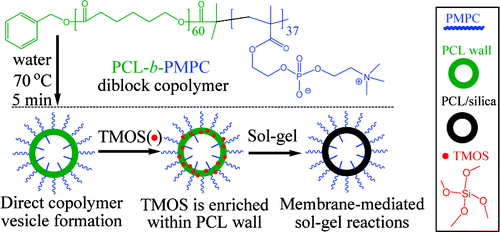Preparation of Biocompatible Zwitterionic Block Copolymer Vesicles by Direct Dissolution in Water and Subsequent Silicification within Their Membranes
作者:Jianzhong Du,Steven P. Armes 时间:2009-07-02 点击数:

Abstract
The facile preparation of block copolymer vesicles in pure water and their subsequent stabilization by sol−gel chemistry within the vesicle membrane is described. An amphiphilic biocompatible zwitterionic diblock copolymer, poly(ε-caprolactone)-block-poly[2-(methacryloyloxy)ethyl phosphorylcholine], PCL-b-PMPC, was synthesized by (i) ring-opening polymerization of ε-caprolactone, (ii) end-group modification by esterification, and (iii) atom transfer radical polymerization (ATRP) of 2-(methacryloyloxy)ethyl phosphorylcholine (MPC). Unusually, block copolymer vesicles were formed instantly upon adding dried copolymer powder into hot water without using organic cosolvents, pH adjustment, or even stirring. This protocol is much more convenient than previously reported methods such as solvent-switching and film rehydration. The PCL vesicle membrane is moderately hydrophobic and fully biodegradable. The highly biocompatible PMPC chains are expressed on both the exterior and interior surface of the membrane. These vesicles can be stabilized by aqueous sol−gel chemistry within the hydrophobic PCL vesicle membrane by using tetramethyl orthosilicate (TMOS) as the silica precursor in the absence of any external catalyst. The water-immiscible TMOS precursor is initially solubilized within the hydrophobic membrane prior to its in situ transformation into silica. The vesicles were characterized by 1H NMR spectroscopy, atomic force microscopy, transmission electron microscopy, and dynamic light scattering.
文章链接:Langmuir 2009, 25, 9564–9570.